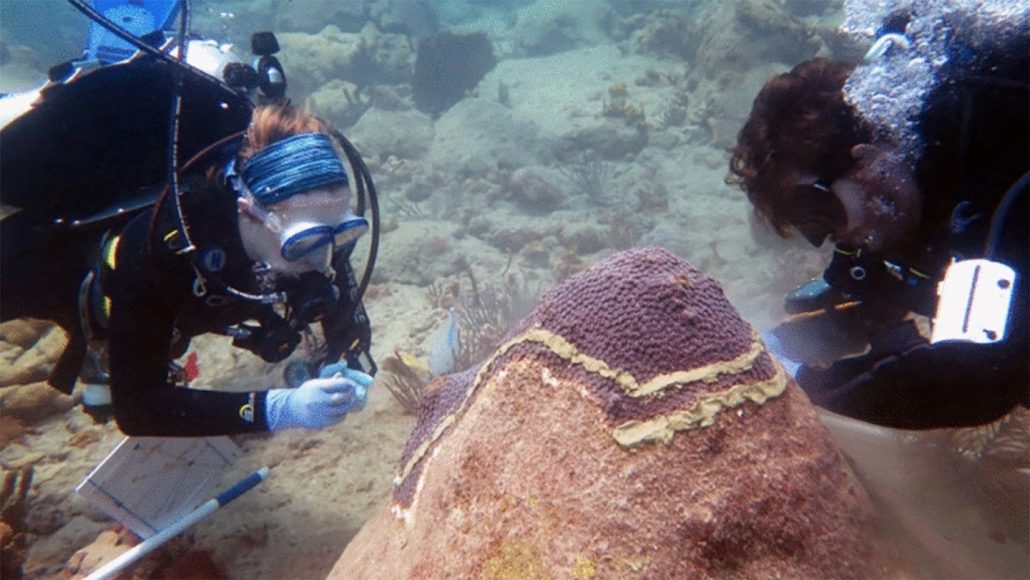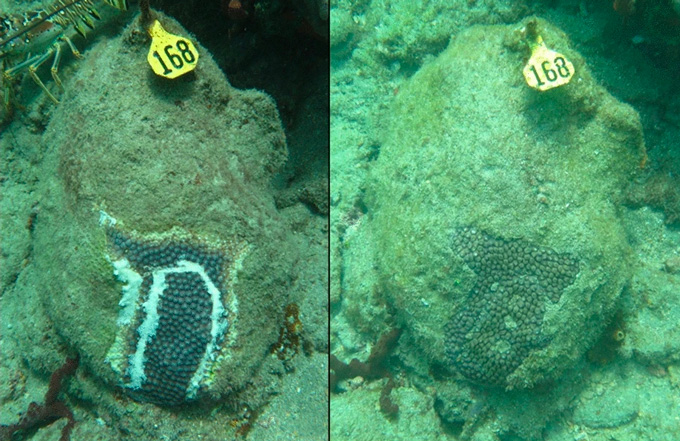A common antibiotic might save some sick corals
Amoxicillin is 95 percent effective at halting a deadly tissue-eating disease

Divers testing treatments for a deadly coral disease apply chlorinated epoxy to great star corals off the coast of Florida.
E.N. Shilling, I.R. Combs and J.D. Voss/Scientific Reports 2021
A dose of antibiotics seems to help some corals recover from a mysterious tissue-eating disease. And yes, they’re the same antibiotics used in people.
Divers discovered the coral disease in 2014. It was afflicting reefs near Miami, Fla. Nicknamed skittle-D, it appears as white lesions that rapidly eat away at coral tissue. The disease has no cure. It currently plagues nearly all of the Great Florida Reef, which spans some 580 kilometers (360 miles). In recent years, skittle-D has spread to reefs in the Caribbean.
Now, a type of coral with skittle-D just off the Florida coast has improved several months after being treated with amoxicillin. Researchers reported the findings April 21 in Scientific Reports. The deadly disease came back on some treated coral over time. But the results provide a spot of good news.
“Antibiotic treatments give the corals a break,” says Erin Shilling. She works as a coral researcher at Florida Atlantic University in Fort Pierce. “It’s very good at halting the lesions it’s applied to.”

Testing treatments
What causes skittle-D remains unknown. So scientists are left to treat the lesions it causes through trial and error. Two treatments show promise. In one, divers apply a material known as a chlorinated epoxy. In another, divers use an amoxicillin paste.
Shilling and her colleagues wanted to see if either worked as well as some people have been saying. In April 2019, her team found 95 lesions on 32 colonies of great star corals. The scientists dug trenches to surround the lesions. Trenches separate diseased coral tissue from healthy tissue. The team then filled the moats and covered the lesions with the paste or epoxy. Scientists monitored the corals for 11 months.
Within about three months, some 95 percent of lesions treated with amoxicillin had healed. Meanwhile, only about 20 percent of the epoxy-treated lesions had healed in that time. That rate was no better than in untreated lesions.
But a one-and-done treatment doesn’t stop new lesions from popping up, the team found. Some key questions also still need answers, the scientists note. For instance, how long does the treatment work and in which coral species. Scientists are also trying to figure out what side effects antibiotics might pose to the corals.
Cause for hope
“Erin’s work is fabulous,” says Karen Neely. She is a marine biologist at Nova Southeastern University in Fort Lauderdale, Fla. Neely and her team see similar results in their two-year experiment at the Florida National Marine Sanctuary. Her group used the same paste and epoxy treatments on more than 2,300 lesions. Those lesions affected some 1,600 coral colonies.
The antibiotic was more than 95 percent effective across all eight species tested, Neely says. New lesions popped up after the initial treatment. But covering those new patches with paste appeared to stop skittle-D from coming back over time. Her team’s findings are undergoing peer-review in the journal Frontiers in Marine Science.
“Overall, putting these corals in this treatment program saves them,” Neely says. “We don’t get happy endings very often, so that’s a nice one.”







